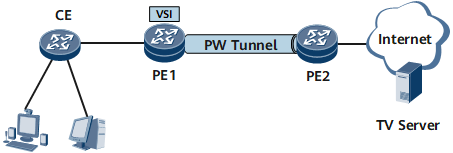Configuring Layer 2 Multicast CAC in a VSI Scenario
Layer 2 multicast CAC configurations are performed in a VSI scenario to limit the multicast group number and bandwidth.
Context
On the network shown in Figure 1, PE1 is downlinked to a residential network and uplinked to PE2 through a VPLS network to access an IPTV server on the Internet. To ensure high PE1 performance, stable multicast data transmission on PE1, and good IPTV service experience, configure Layer 2 multicast CAC for specific VSIs on PE1. If all programs of a service provider are grouped into one or more VSI channels, Layer 2 multicast CAC can also be configured to limit the bandwidth to a specific value for each multicast group in a VSI channel.

On this network, PE1 is a Layer 2 device on which VSI-based Layer 2 multicast CAC needs to be configured.
Before configuring Layer 2 multicast CAC for a VSI, configure an LDP-based VSI.
Before configuring Layer 2 multicast CAC for a sub-interface, configure the sub-interface as a dot1q termination sub-interface and bind the sub-interface to the LDP-based VSI.
Layer 2 multicast CAC configurations can be performed for a VSI channel and for a sub-interface in a VSI.
